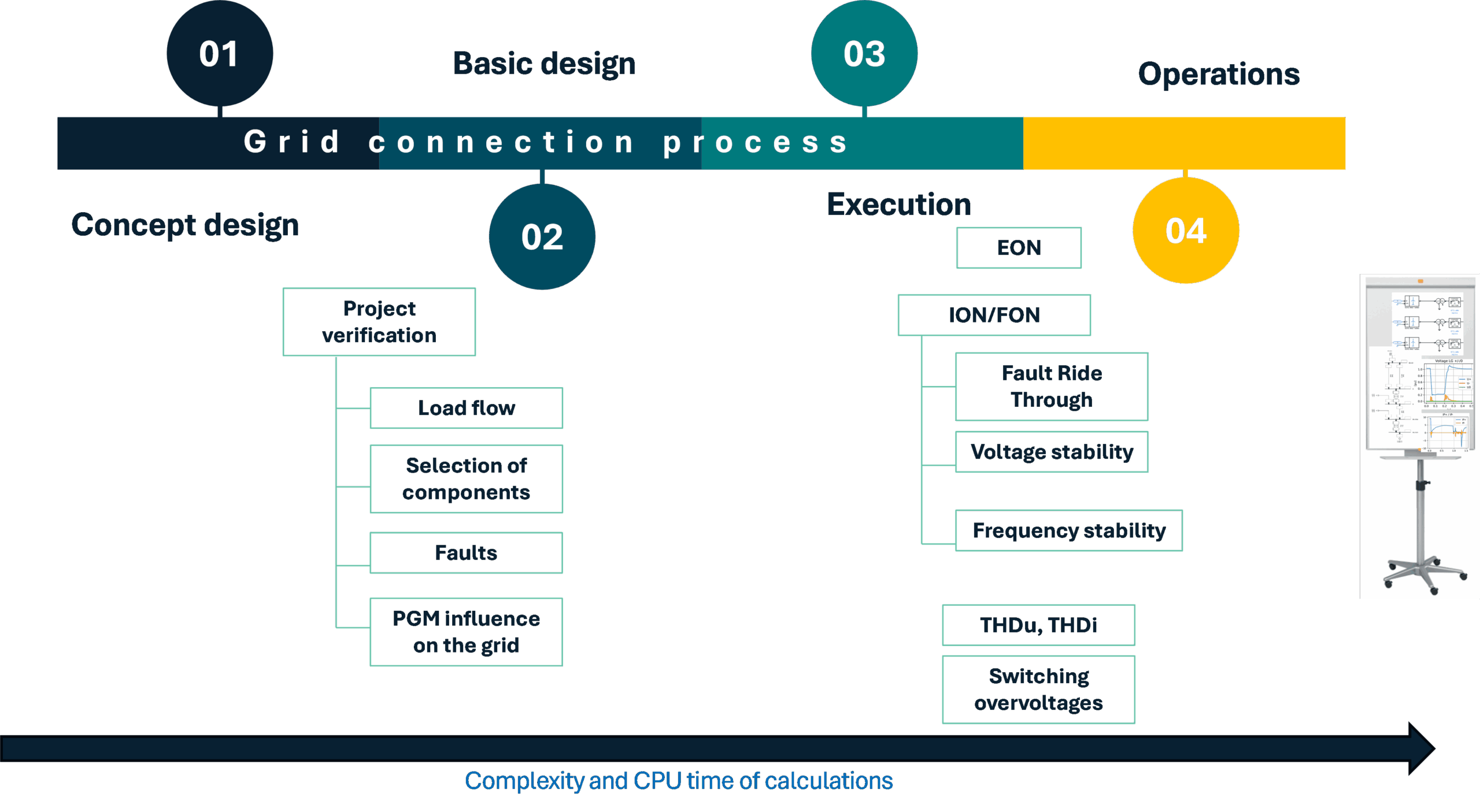Power System Simulations – “Who Needs That, Anyway?”
Power system simulations are now an inevitable part of the broadly understood are of network analysis. It is difficult to describe in simple terms how far we (as engineers) have come – from classic, pioneering calculations done on piece of paper, through perforated FORTRAN cards, to powerful tools providing multidimensional, automated support, often touching on AI. Enchantment can mix with concern – will we still be needed?
Alright, let’s cut the lofty talk and come back down to earth. Let’s think instead about why we need simulations today, what benefits they bring, and what risks they entail. We have a wide range of applications for all kinds of analyses, from planning the operation of the entire National Grid (KSE) over daily, yearly, and even three-year horizons, to high-frequency overvoltage simulations, whose durations are measured in single μs (yes, microseconds – millionths of a second).
For obvious reasons, as a business oriented person, I will focus here on those analyses that can be monetized (the reader is kindly asked to appreciate the author’s honesty). Analyses and forecasts for the operation of the entire KSE are carried out by specialized planning units at PSE, which ensure system security by constant monitoring of frequency and voltage stability. We, however, will be more interested in the operation of individual Power Generating Modules (PGM), in the context of their capabilities defined by the NC RfG and NC ER codes. To start – what is the legal status in Poland?
Most often, we deal with mandatory simulations as part of the ION/FON process (respectively, Annexes 5 and 4). The purpose of these simulations is to demonstrate that the given PGM has capabilities that cannot be tested physically. Can we imagine performing a series of faults on-site just to prove that a Power Generating Unit (PGU) can deliver 90% additional capacitive reactive current in less than 60 ms? As an engineer, I would be thrilled to take part in such tests – I’m just not sure if the Relevant System Operator (RSO) and the Power Generating Facility Owner (PGFO) would share my enthusiasm. Another example in the same universe – confirming the ability to generate reactive power at maximum active power output. Let’s imagine this conversation between the tester and the RSO’s dispatcher:
- Please lower the grid voltage to 0.875 pu, I need to check the ability to generate maximum capacitive reactive power, in accordance with NC RfG requirements.
- No problem, executing now.
The absurdity of this dialogue is obvious, and there is little point in commenting further.
So, are simulations just a necessary attachment to the ION/FON process? The answer is obvious – but if we want to issue the Client an invoice for additional analyses, let’s also look for the benefits.
Let’s look at the diagram below, which shows the phases of the connection process. Selected examples of analyses that must (or may) be provided to the Relevant SO by the PGFO are presented.

So, what has slipped in here besides the previously mentioned ION/FON?
- Project verification – already at the early concept stage it is possible to perform P-Q and U-Q analyses to preliminarily verify whether the proposed design will meet code requirements. Benefit? Possible optimization of the design in terms of the number of PGUs, oversizing of the PGM, or the installation of additional compensation devices.
- THDi, THDu – at the advanced stage of the project, knowing the selected components (especially converters), it is possible to determine the expected values of higher harmonics in the Point of Connection (POC)
- EON – wait, wait? what’s this about? are you trying to rob me?” Relax – there is no requirement for additional analyses before energizing the facility. However, there is a certain magic clause in the “Procedure for testing power generating modules along with the division of responsibilities between the owner of the power generating plant and the system operator for testing purposes,” which reads as follows: “The Relevant SO has the right to define and determine additional tests to confirm compliance with the requirements.”
This clause allows the Relevant SO to request proof that the given PGM is not an aircraft carrier or perhaps a camel. More seriously – what does this have to do with EON? Energization is nothing more than applying voltage to the passive components of the PGM, i.e., transformers and cables. Such switching operations may be associated with significant maximum overvoltages and overcurrents – important for certain system configurations and network conditions.
Here, we could attempt to list more detailed analyses, touching on aspects related to ferroresonance, lightning overvoltages, switching overvoltages involving vacuum circuit breakers or those in SF6 insulated substations – but that would take us down an increasingly narrow path. A path extremely interesting (enthusiasts use the word fascinating), but rather considered niche – chosen only in very specific cases.
It is worth mentioning the modern tools we have today for power system analysis. As I mentioned at the beginning, the romantic (really?), pioneering times of coding calculations in FORTRAN on special punched cards are long gone. Today, programs such as PSS/E, Power Factory, and PSCAD give us enormous capabilities for steady-state and dynamic analyses. However, one must ask: should we blindly trust the results of the aforementioned analyses? I dare say that not only should we not, but we absolutely must not. Blind faith in the operation of computational algorithms is a dangerous trap, especially for young engineers. The paradox is that the program will accept anything, almost any nonsense (excuse the colloquialism), and if the solver doesn’t have to divide by zero, it will produce a result. It is up to the engineer to assess the relevance (correctness) of that result, which is why it is so important to constantly verify, question, and test the actual capabilities – both our own and those of the PGM under study.
Finally, let me say a few words about AI. Will we – analysts – be replaced by “the machine”? Or perhaps I should start the question with “when”? Looking at the briefly mentioned history of the development of methods and computational programs, I see no reason why the ongoing automation of calculations should not evolve into true AI, suggesting or even making design decisions for us. Today, AI is used in solid-state physics research or in the analysis of protein structures, and moreover – it is widely used in power engineering, mainly in predictive algorithms for forecasting trends in energy prices.
So why shouldn’t this development go further? It all comes down to a mathematical, physical, biological problem – and in power systems – also a statistical one. If 15 years ago we had said out loud that each of us would have access on our mobile phone to an app (today’s ChatGPT or another LLM) that could easily draw us a picture of Santa Claus in PPE performing measurements at a PV farm in a few seconds, probably few would have taken us seriously. Today, we get the result of such a prompt in seconds. So why is it so hard to imagine a situation where we ask artificial intelligence a properly formulated question – and let me indulge in a bit of fantasy: “Please design a photovoltaic farm in municipality X, town Y, on piece of land Z. Assume such-and-such power, take into account solar irradiation according to geographic latitude, parameterize the installation in terms of NC RfG requirements, perform analyses according to NC ER, import data from TGE, and run a cost and profit prediction.” Then we let the algorithms work while we enjoy freshly brewed coffee, and after a few minutes we receive complete technical documentation, elegantly formatted in PDF files, not in the form of some chaotic scribbles. Impossible? Time will tell – once upon a time, creating Santa in seconds was also impossible. Today, this figure, caught in the act of performing complex measurements, smiles at us – although our Santa looks like he doesn’t quite know what he’s doing, he will surely learn. Let’s end these musings on a positive note – personally, I believe that for many years to come the driver (analyst/designer engineer) will remain essential. Let’s not predict the apocalypse too early.

Dictionary of a young simulation engineer
Acronym | Definition |
NC RfG | Network Code on Requirements for Grid Connection of Generators, EU Commision, 2016/631, 14.04.2016 |
NC ER | Network Code on Electricity Emergency and Restoration, EU Commision, 2017/2196, 24.11.2017 |
PGM | Power Generating Module |
PGU | Power Generating Unit |
POC | Point of Connection |
RSO | Relevant System Operator |
PGFO | Power Generating Facility Owner |
TGE | Energy Exchange Market |
KSE | National Grid |
EON | Energization operational notification |
ION | Intermediate operational notification |
FON | Final operational notification |
THDi, THDu | Total harmonic distortion in current and voltage |